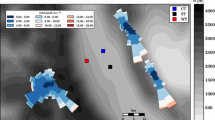Abstract
We examine methods for the interpretation of sodar facsimile records obtained in the study of complex terrain flows. Acoustic scattering theory is presented first and then interpreted using a simpolified second-order turbulence closure scheme. The use of this theory suggests the strong sensitivity of acoustic scatter to changes in the wind shear. With this introduction, detailed sodar facsimile records, temperature and wind profiles, and model calculations follow. Characteristic scattering patterns are described for simple drainage jets, complex basin flows, convection with a capping inversion, stratus, and dynamical instabilities. Examples are also shown of bistatic facsimile records detailing the strong temporal and spatial variability in small-scale turbulence.
Similar content being viewed by others
References
Brost, R. A. and Wyngaard, J. C.: 1978, ‘A Model Study of the Stably Stratified Planetary Boundary Layer’, J. Atmos. Sci. 35, 1427–1440.
Brost, R. A. and Wyngaard, J. C.: 1979, ‘Reply’, J. Atmos. Sci. 36, 1821–1822.
Burk, S. D.: 1980, ‘Refractive Index Structure Parameters: Time-Dependent Calculations Using a Numerical Model’, J. Appl. Meteorol. 19, 562–576.
Fitzjarrald, D. E., 1979: ‘On Using a Simplified Turbulence Model to Calculate Eddy Difusivities’, J. Atmos. Sci. 36, 1817–1820.
Gossard, E. E. and Hooke, W. H.: 1975, Waves in the Atmosphere, Elsevier, Amsterdam, The Netherlands, 456 pp.
Horst, T. W. and Doran, J. C.: 1986, ‘Nocturnal Drainage Flows on Simple Slopes’, Boundary-Layer Meteorol. 34, 263–286.
Izumi, Y. (ed.): 1971, Kansas 1968 Field Program Data Report, Air Force Cambridge Research Laboratories, Environmental Research Papers, No. 379 (AFCRL-72-0041), Available Nat. Tech. Inform. Service.
Kaimal, J. C., Abshire, N. L., Chadwick, R. B., Decker, M. T., Hooke, W. H., Kropfli, R. A., Neff, W. D., Pasqualucci, F., and Hildebrand, P. H.: 1982, ‘Estimating the depth of the Convective Boundary Layer’, J. Appl. Meteorol. 21, 1123–1129.
Manins, P. C. and Sawford, B. L.: 1979, ‘A Model of Katabatic Winds’, J. Atmos. Sci. 36, 619–630.
Neff, W. D.: 1980, ‘An Observational and Numerical Study of the Atmospheric Boundary Layer Overlying the East Antarctic Ice Sheet’, Ph.D. Dissertation, University of Colorado, Boulder, 272 pp.
Neff, W. D. and Coulter, R. L.: 1986, ‘Acoustic Remote Sensing’, in D. H. Lenshow (ed.), Probing the Atmospheric Boundary Layer, Amer. Meteorol. Soc. Boston, Mass., pp. 201–236.
Neff, W. D. and King, C. W.: 1987, ‘Observations of Complex-Terrain Flows Using Acoustic Sounders: Experiments, Topography, and Winds’, Boundary-Layer Meteorol. 40, 363.
Nieuwstadt, F. T. M.: 1984, ‘The Turbulence Structure of the Stable, Nocturnal Boundary Layer’, J. Atmos. Sci. 41(14), 2202–2216.
Wyngaard, J. C.: 1975, ‘Modeling the Planetary Boundary Layer: Extension to the Stable Case’, Boundary-Layer Meteorol. 9, 441–460.
Author information
Authors and Affiliations
Rights and permissions
About this article
Cite this article
Neff, W.D. Observations of complex terrain flows using acoustic sounders: Echo interpretation. Boundary-Layer Meteorol 42, 207–228 (1988). https://doi.org/10.1007/BF00123813
Revised:
Issue Date:
DOI: https://doi.org/10.1007/BF00123813




